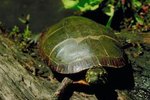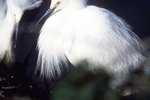
Tortoises reach sexual maturity between 10 and 20 years old, when their carapace, or upper shell, reaches 6 to 8 inches long. They're polygamous, mating with many partners. Dominant males mate more often than less aggressive males. The female tortoise is able to store sperm in her cloaca, fertilizing her eggs for up to four years after copulation.
Breeding Tortoises are Aggressive
The male tortoise is most aggressive during mating season. When another male is encountered, he bobs his head in warning, stands tall and attacks. He uses his head and neck in an effort to flip his rival. A long, curved spur, called a gular, is located in the throat area of his plastron, or bottom shell. The tortoise can inflict a lot of damage with his gular, tearing his enemy's skin and shell.
Their Courtship is Rough
Courtship occurs during spring and summer. Male and female tortoises can be aggressive, but the female usually gives in eventually. The male circles the female, often nodding his head and biting at her legs and the edges of her carapace. He rams into her, attempting to trap her, so she can be mounted. Their mating is a noisy affair, filled with the sounds of hissing and grunting, while the male vigorously stamps his hind feet.
Mom Urinates on Her Nest
The female tortoise digs a burrow with her front legs, then backs in and enlarges the egg chamber, using her back legs. She lays from 12 to 40 eggs in the chamber before covering the nest. She urinates on and around the nest to keep predators away. Some females guard their nests until the young hatch, which usually takes 80 to 120 days. No parental care is given to the hatchlings.
How to Distinguish Males From Females
The mature male tortoise's tail is longer than the female's. His plastron is concave, and the back of his carapace curves inward, enabling him to easily mount the female. The mature female's plastron is flat, and the back of her carapace flares outward. The male tortoise secretes scent with glands located under his chin, which may attract females, as well as eliciting aggression from other males.
References
Photo Credits
-
Jupiterimages/Photos.com/Getty Images
Writer Bio
Karen Mihaylo has been a writer since 2009. She has been a professional dog groomer since 1982 and is certified in canine massage therapy. Mihaylo holds an associate degree in human services from Delaware Technical and Community College.




